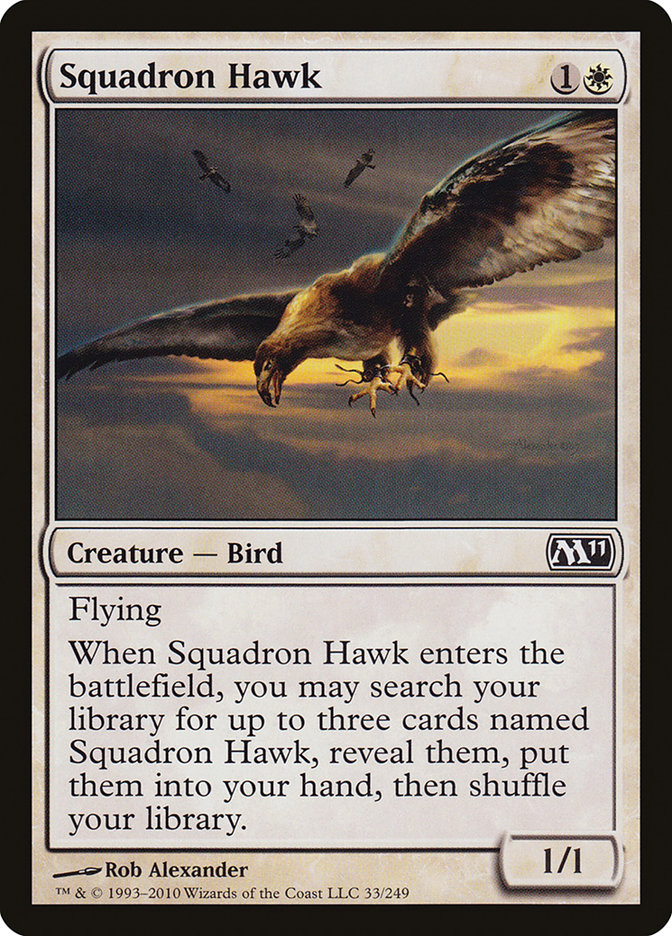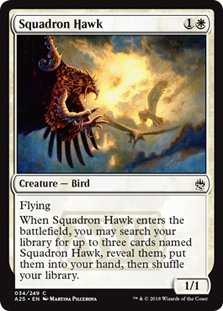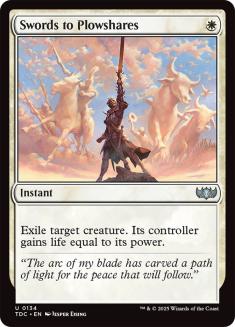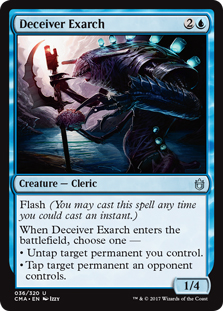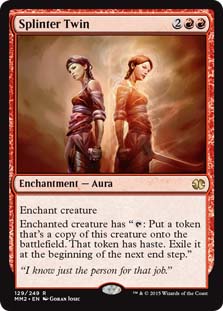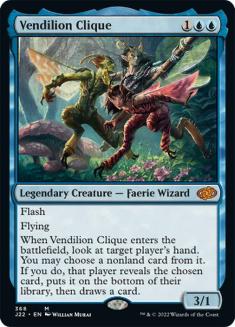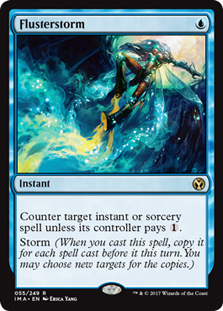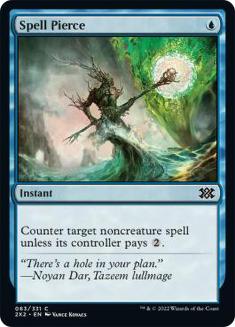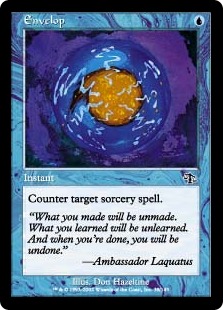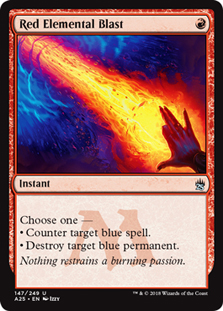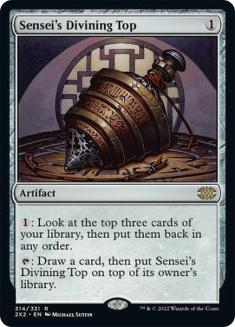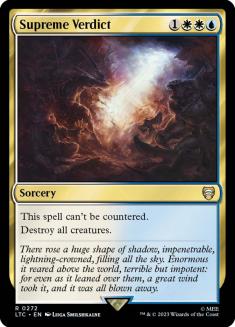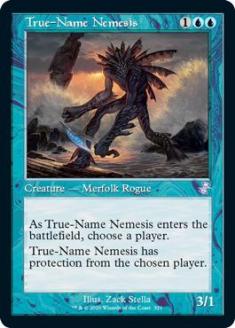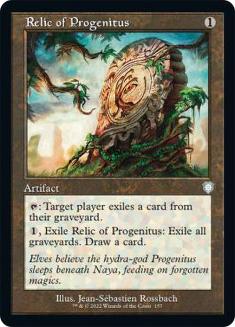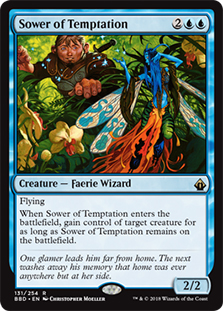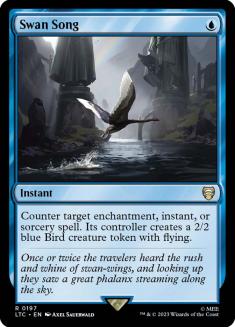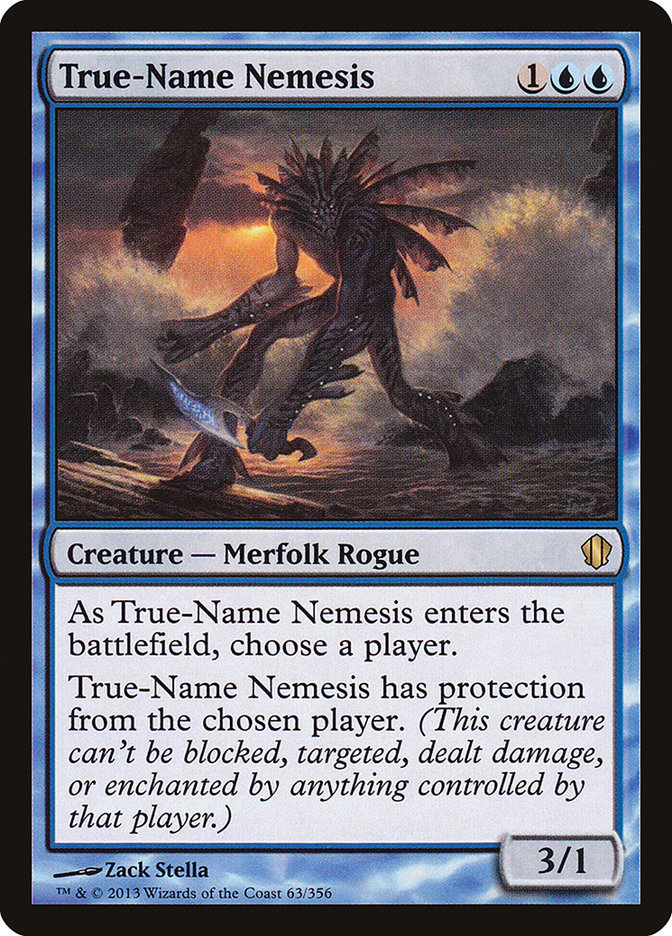This deck is a little odd to be writing about. It isn’t a brew in the traditional sense of the word. It was the monster of its time, it won countless
tournaments in various forms, and parts of it have made it to Legacy.
The thing is, it was a Standard deck three years ago. The parts just happen to be well-positioned for Legacy.
Stoneforge Mystic is a perfectly fine card. Powerful, versatile, sees play in any number of decks.
Squadron Hawk has seen almost no Legacy play despite its ability to harass planeswalkers, carry equipment, and draw cards better than any other creature in
existence.
Finally, Deceiver Exarch and Splinter Twin have seen no real competitive Legacy play. There are plenty of two-card combos in the format, and the “best”
removal-vulnerable two-card combo is still Cephalid Illusionist and Nomads en-Kor at one-plus-two mana, so there has to be pretty serious upside to a
removal-vulnerable combo that costs three-plus-four. Fortunately, there is.
This idea came from a series of thoughts about how and why Stoneforge Mystic decks lose games. Here was my checklist:
– They get out-attritioned, with Batterskull not being enough against an eventual Jace + Liliana team or a 20/20 Marit Lage token.
– They get combo’d out in the three or four turns that Mystic + Batterskull are taking to actually kill on an open board.
– They get tempo’d out by Delver of Secrets plus countermagic.
– They get all of their stuff killed and get slowly Jace’d out by Miracles.
I think that Legacy as a format is big enough to offer solutions to these problems. So how should these weaknesses be addressed? What cards are good, what
cards are bad, and where can the deck go?
The first issue–losing to base-black attrition decks–is actually really easy to solve. In a world where someone keeps casting Raven’s Crime, you just
have to keep casting Ancestral Recall. How do you do that?
If my opponent is casting Hymn to Tourach, I want to have Ancestral Vision. If my opponent has Liliana of the Veil though, it’s hard to imagine having a
better card than Squadron Hawk. Although many people have called Lingered Souls “a better Squadron Hawk,” I think that Hawk does a lot of work that Souls
can’t do.
Unlike Lingering Souls, Squadron Hawks two, three, and four can be Brainstormed back and Jace’d back into the deck to be found again for raw card
advantage.
Unlike Lingering Souls, Squadron Hawk could not possibly care less about Terminus. A Wrath of God that puts creatures back in my library? Yes, please!
Unlike Lingering Souls, Squadron Hawk can’t be Flusterstormed or Spell Pierced. In a world where Legacy is bending to the influence of tempo-oriented
Delver decks, costing 33% less is real.
It also bears mentioning that playing with Lingering Souls would preclude playing with Splinter Twin given the presence of Wasteland in the format. In that
sense, Squadron Hawk is less of a constraint on mana.
Let’s not pretend that a two-mana Suntail Hawk is the best thing since sliced bread though. Squadron Hawk is obviously the weakest card in the deck. It
hasn’t seen much play since its Standard rotation, and a lot of that has to do with mana efficiency. Playing Squadron Hawk in Legacy is going to require a
commitment to building a deck with multiple basic lands and a slow, attrition-oriented gameplan. It’s just that I sincerely believe that Squadron Hawk is
one of the best ways for white creature decks to beat black attrition decks that play Liliana of the Veil.
With that out of the way, let’s talk about Stoneforge Mystic.
It’s good.
We’re playing it.
It finds equipment.
Equipment and “flying” go well together.
Given the presence of Squadron Hawk in the deck, we’re going to have a lot of ways to use our mana, so Sword of Feast and Famine is worth maindecking; it
lets us play a board-position game against midrange decks and lets us meaningfully interact with combo decks.
Batterskull and Umezawa’s Jitte are still quite good.
That’s all I got. Four Stoneforge Mystic. Check.
Now for the fun part of the program.
Deceiver Exarch provides this deck full of white two-drops with a way to win games against combo decks. Let’s talk about that for a bit. What combo decks
do people play in Legacy? Elves, Sneak and Show, Storm, Reanimator, and Infect, right?
Against Elves and Storm, Exarch into Twin on turn 4 is a way to win before they do. Neither deck plays removal or stack interaction, so if you can cast two
cantrips and a piece of interaction before turn 3, you’re in good shape. Deceiver Exarch will function as another piece of interaction (a sort of
preemptive Daze), and you’ll have to hope that Splinter Twin doesn’t get Duressed in that window.
Against Reanimator, you’re just a U/W Stoneforge Mystic deck with Jace, the Mind Sculptor. Historically, this has been a good spot to be in for the Jace
player, although Exarch certainly provides a little more equity by tapping down Griselbrand for a turn.
Deceiver Exarch is phenomenal against Sneak Attack. I don’t need to explain this one.
Deceiver Exarch is also quite good against creatures that need to attack in order to win which Infect is full of. Buying a turn with that angle is real
enough too.
The real power of Deceiver Exarch and Splinter Twin, however, is context. Everyone who has a removal spell available will use it on a turn 2 Stoneforge
Mystic. If the choice is between Lightning Bolt and Swords to Plowshares, it’s not even clear that the Mystic is going to eat a Plow, since any
blue-and-white Stoneforge Mystic deck is likely to be packing Jace, the Mind Sculptor, and you would rather line up a Bolt than a Plow against a Jace.
Of course, Deceiver Exarch doesn’t much care about a Lightning Bolt, so the context of playing it in a deck with Stoneforge Mystic and Jace is likely to
protect it from Swords to Plowshares.
If you imagine what a dedicated Splinter Twin combo deck in Legacy would look like, you would probably end up putting together a deck that looks and acts a
lot like Sneak and Show except it would be intensely vulnerable to removal and wouldn’t have a great Plan B. Given that Splinter Twin’s critical turn
always starts with a down payment of four mana, defending it with Spell Pierce or Flusterstorm is untenable. A far better plan is to make sure that they’re
dead in the water when you decide to target Deceiver Exarch with Splinter Twin.
If you start to think of Stoneforge Mystic as a Spellskite that can win the game on its own, you’ll get a sense of how this deck can be played. Rather than
treating it like a pure Twin deck, you can pretend to be a midrange deck for a really, really long time and win if and when you get a window. If you don’t
get a window, it’s because your opponent is holding mana up every turn. That mana could be used for something else, but it’s being used to forestall a
potential Twin-driven kill.
In other words, the mere presence of Deceiver Exarch forces your opponent to play differently. Whether they choose to give you credit for having Splinter
Twin or not, they have to make choices that–some percentage of the time–are wrong. Since people tend to dislike flat-out losing a lot, many people will
err on the side of playing conservatively, opting to hold up mana to counter a Splinter Twin or kill Deceiver Exarch. They may also preserve their removal
in sideboarded games, fearful of a Splinter Twin kill that may never come. These are the sorts of subgames that Deceiver Exarch creates. Being a
combo-control deck is valuable both in the tactical sense (being able to win with Splinter Twin) and in the meta sense (being able to credibly threaten
your opponent with the prospect of ending the game out of nowhere, thus impacting their lines of play).
The rest of the deck is more or less window dressing for those creatures. Whereas Modern Splinter Twin can only play Serum Visions and Sleight of Hand to
piece its combo together, this deck can play Brainstorm and Ponder, both to great effect. Ponder is excellent here as a way to find a critical two-drop for
turn 2, maximizing mana efficiency and consistency. Swords to Plowshares is an obvious inclusion, Force of Will is an obvious inclusion, and Jace, the Mind
Sculptor is an easy call with Squadron Hawk already in the deck. That leaves us with the following set of spells:
4 Ponder
You will note that this deck is not particularly interested in interacting on the stack. In a world where you need to do that, a more traditional Delver +
Stoneforge Mystic deck is likely preferable. In a world where people are casting Shardless Agent and Baleful Strix, however, this deck can build a better
Baleful Strix than anyone else.
This spell configuration leaves room for 23 lands. As I discussed earlier, we definitely want a lot of basic lands, as we’re interested in casting
four-drops on turn 4. If we template our mana to the old-school Esper Stoneblade deck of Sam Black and Tom Martell days, we want four basic lands (two
Island), nine fetchlands in a 4/3/2 configuration, six blue duals, one non-blue dual, a Karakas, and a utility land. Since that’s only 22 lands, we can
add an eighth dual (it needs to be red given that we need to cast Splinter Twin on time). We arrive at the following manabase:
3 Tundra
2 Plateau
2 Island
1 Plains
1 Mountain
1 Karakas
I don’t think this is a deck that can afford to miss its land drops, so I’m not super interested in cutting things down to 22 lands to fit in more action.
Being able to consistently cast spells on time is a quality that not every Legacy deck possesses. This one needs it.
Our maindeck looks fairly streamlined despite having a bunch of Brainstorms and Ponders. This gives us a great excuse to go nuts with our sideboard since
we’ll be able to dig to our one-ofs better than almost any other deck in the format. For starters, let’s look at what we want to cut in various matchups:
Combo:
Out:
In sideboarded games, this deck wants to play an instant-speed game after turn 2. That can entail more cheap countermagic, some number of Vendilion
Cliques, narrower hate cards like Relic of Progenitus or Ethersworn Canonist, or all three.
Control:
Out:
There are a ton of angles we can take here. All of our gameplans are viable against a deck like Miracles or Shardless BUG, with only the creature removal
being truly bad. Cutting an entire gameplan (sideboarding out Exarch and Twin, for instance) would end up being a matter of reading the way that the match
has played out and getting in your opponent’s head enough to see what they think is important.
Tempo:
Out:
This is the easy part; Splinter Twin is unlikely to ever resolve, so cutting that is easy. Red Elemental Blast is a big game, so getting those in the deck
is nice. From there, it’s just a matter of flooding the board and keeping their threats under control. Trying to fight a Delver deck on the stack is a
losing battle, so try to make the game about that.
A short list of cards I would want to play out of the sideboard of a board-focused UWR combo-control deck is:
Given how many cards we want to take out against combo decks of all shapes and sizes, we have a choice about how to proceed. Either we can ignore a few
strategies and focus on the rest, or we can play a wide range of cards that are somewhere between “playable” and “excellent” against all of our expected
matchups. Since I hate getting blown out by the pairings gods, I’ll opt for the second. Besides, it suits my preferences far more; playing one-of sideboard
cards is sweet!
Against combo, therefore, we can play these eight cards to decent effect:
Swan Song pulls all sorts of weight, countering everything from Sneak Attack to Show and Tell to Terminus to Infernal Tutor. Flusterstorm has added utility
against Delver of Secrets decks as a way to slow the game down by picking off early cantrips. Vendilion Clique puts in a ton of work against Miracles, any
combo deck, and as another threat in games where Deceiver Exarch and Splinter Twin isn’t a feasible game plan. Red Elemental Blast is still one of the best
sideboard cards in the format, and it’s reasonable to want to play three.
Our plan against tempo decks is to board out the Exarch/Twin package since Splinter Twin is unlikely to ever resolve. It is possible that we want to leave
some number of Deceiver Exarchs in against RUG Delver because Horned Turtle matches up well against Trained Armodon (Nimble Mongoose), but Splinter Twin is
an easy cut. Given that we want a potent card against a Delver deck, it makes sense to pick one that is invulnerable to removal. Fortunately, such a card
already exists:
We can play four of those without a worry, allowing us to transform into a threat-dense board-oriented deck against someone holding a bunch of soft
counters. The Nemeses, along with the Flusterstorm and the two Red Elemental Blasts, can serve as a starting sideboard plan for tempo decks.
This leaves the last three slots for midrange and control decks. I want to have access to a Wear/Tear against Counterbalance and Umezawa’s Jitte, as well
as a Sower of Temptation against Abrupt Decay and Tarmogoyf, so we’re really looking at one more card. Given that we’re still pretty light on ways to
interact with noncreatures, I’d like either a second Wear/Tear or something even more punishing like Aura of Silence. Since I can basically never get
enough of Aura of Silence in my UWx Control decks in Legacy, it’s making the cut. I hope we play against Enchantress!
The final 75:
Creatures (12)
Planeswalkers (3)
Lands (23)
Spells (22)

I have high hopes for this deck. It checks all of the boxes required for me to get excited: it’s a new riff on a proven strategy, it plays some off-label
cards, it attacks an existing metagame in a deliberate way, it can win by casting its spells on time and attacking, and (just for the folks at home) it’s
fairly portable from a Modern collection. In short, I’m really looking forward to seeing how this plays out.

